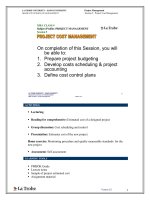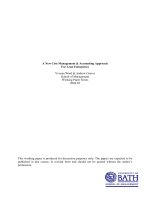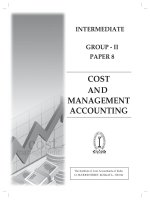Cost management training day4
Bạn đang xem bản rút gọn của tài liệu. Xem và tải ngay bản đầy đủ của tài liệu tại đây (1.56 MB, 41 trang )
Training Agenda/Objectives
• Day 1: Cost Management Overview
– Understanding of why managing costs are important, Army’s
overall objectives, the process of Cost Management, how it
differs from Budget, and key cost terms
• Day 2: Cost Object Definition
– Understanding of an ERP, how to build a Cost Model, and the
various cost objects within a Cost Model (e.g. organization,
products, job orders, etc.)
• Day 3: Assignment of Costs
– Understanding of cost allocations/assignments, how to chose
which to utilize when, how to valuate the results of the
assignments (Std. vs Actual), and rate creation
• Day 4: Analysis and Reporting
– Understanding of the results of the Cost Model and how various
types of analysis and decisions are supported
Day 4 Objective & Agenda
Day 4: Analysis and Reporting
• Understanding of the results of the Cost Model
and how various types of analysis and decisions
are supported
–
–
–
–
Lesson 1: Exercise
Lesson 2: Analysis
Lesson 3: Reporting
Lesson 4: Summary/Key Take-Aways
Lesson 1: Exercise
Objective(s):
• Break out into teams
• Define Cost Centers/Activity Types
• List types of costs
• Identify senders (provide services) and customer
(who your team provide services to)
• Sample Outputs
Lesson 2: Analysis
Objective(s):
• Understand different types of analysis and
how reporting can support analysis
Current Status
• W
hat
kin
ds
of
an
aly
sis
oc
cur
no
w?
–S
Costs Analysis Types
• For
ec
ast
ing
:
usi
ng
pri
or
per
iod
info
rm
atio
n
to
pre
dict
fut
More Costs Analysis Types
• Co
st/
Be
nef
it
An
aly
sis
:
An
aly
sis
of
De
cisi
Analysis Supported by ERP
Reporting
The
vario
us
type
s of
anal
ysis
are
supp
orte
d by
ERP
repo
Sample Analysis
Price Variance
Quantity Variance
Change in Total Cost
No Change in Activity
Drives Change in Unit $
Cost Variance
Change in Activity
No Change in Total Cost
Drives Change in Unit Cost
Change in Activity
No Change in Unit Cost
Drives Change in Total Cost
Budget Execution
Before & After GFEBS
• The way GFEBS reports Budget Execution information is very different than
current environment
• The current view of COED is called Cumulative in GFEBS reporting
• Both views of Budget Execution will be provided
Lesson 2: Wrap-Up
• There are many kinds of analysis each with a different
purposes and supporting different decisions
• ERP reporting supports/enahnces analysis through realtime, accurate, transparent data buolt within a common
framework of definitions, business rules, and processes
• Reports are generated around the type of analysis being
performed
• Some reports within GFEBS will provide the ability to see
COED as cumulative
D3L2_p6
Question
ERPs support analysis by (check all that apply):
o
Real-time, accurate data
o Drill-down capabilities to generating document
(e.g. transparency and audit/integrity)
o Standard definitions, business rules, and
methods (commonality in what the data
means)
o Multiple cost assignments and views
o Does the analysis for you
X
D3L2_p6
Lesson 3: Reporting
Objective(s):
• Understand an overview of the types of
cost reports supported by GFEBS
GFEBS Cost Reports
for Multiple Needs
•
•
•
•
By Appropriation
Direct Funds
Reimbursements
Full Cost
Direct Funds
Mil Pay
Foreign Labor
Indirect Funds
Overhead
GFEBS System Components
ECC – Enterprise Central Component
BI – Business Intelligence
FI – Financial Acct. & Mgmt.
Cost By
Report
FM – Funds Acct. & Mgmt.
CO – Cost Acct. & Mgmt.
Unit Cost
Report
MM – Materials Mgmt.
and Procurement
PPE – Property, Plant &
Detailed
Labor
Report
Equipment [PM, PS, RE, AA]
SD – Sales & Reimbursables
D2L1_p11
•
•
•
•
Optimized for Data Input
Transaction Processing
Real-time; recon analysis
Structured reporting
•
•
•
•
Optimized for Data Extraction
Analytical Processing
Near real-time; trending analysis
Slice-n-dice reporting (pivot)
Why ECC vs BI
ECC:
BI:
• Real-time
• Drill-down to originating
document
• Reconciliation
• Period-End and year-end
closing activities
• Support external reporting
• Utilized for auditing activities
• Usually researching a smaller
data set
• Typically set to time-out
within 15 minutes to maintain
system resources for
receiving postings
• Nightly, 4 hrs, near real-time
• Drill-down to some level of
aggregation – detailed line
items researched in ECC
• Reconciliation
• Support internal reporting
• Utilized for costs analysis
activities
• Usually researching a large
data set
• Typically set to time-out
within 90 minutes to support
end-users performing
analysis
ECC Report Types
• Pla
n
vs
Act
ual
Var
ian
ce
s–
eac
h
cos
t
obj
ect
has
a
sta
nd
ECC Report Capabilities
• Mul
tipl
e
Filt
ers
–
eve
ry
std.
rep
ort
has
mult
iple
filter
s/p
ara
met
ers,
e.g.
BI Report Types
• Sta
nda
rd
Rep
ort
s–
mos
t of
the
std.
rep
orts
with
in
EC
C
are
pro
vide
d
with
in
BI Reporting Capabilities
• Us
er
Def
ine
d
Var
ian
ts
–
like
in
EC
C,
use
rs
can
defi
Cost By Report
Cost By Report Variables
GFEBS Sample Cost By
Exportable Cost By Report
for Analysis









